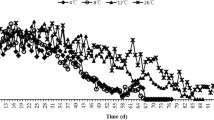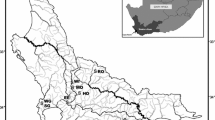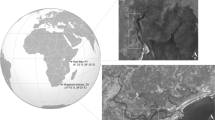Abstract
Experiments have been conducted to determine the final preferred temperature (FPT) and avoided temperatures in cladoceran Ceriodaphnia quadrangular (O. F. Müller, 1785) from the littoral of the Rybinsk Reservoir. The graphic method is used to analyze the experimental data. In the study during the vegetation season the following parameters are determined: range of selected (preferred) temperatures (17.4–26.5°C) corresponding to the optimum temperatures for growth and development of cladocerans in the waterbodies, the temperature zone of normal vital activity (13.0–27.0°C), ranges of avoidance temperatures (6.0–13.0°C and >27.0°C), and lethal temperatures (<6.0 and >33.0°C). The possible reasons and mechanisms of temperature responses in cladocerans are discussed.
Similar content being viewed by others
References
Verbitskii, V.B. and Verbitskaya, T.I., Final thermal preference in parthenogenetic females of Daphnia magna Straus (Crustacea: Cladocera) acclimated to various temperatures, Biol. Bull. (Moscow), 2011, vol. 38, no. 5, pp. 493–499.
Verbitskii, V.B. and Verbitskaya, T.I., Thermal preference and avoidance in cladoceran Daphnia magna Strauss (Crustacea, Cladocera) acclimated to constant temperature, Biol. Bull. (Moscow), 2012, vol. 39, no. 1, pp. 93–98.
Verbitsky, V.B., Verbitskaya, T.I., and Malysheva, O.A., The influence of various temperature regimes on the abundance dynamics and thermal tolerance of cladoceran Ceriodaphnia quadrangular (O.F. Müller, 1785), Inland Water Biol., 2009, vol. 2, no. 1, pp. 67–71.
Kozlova, I.V., On the biology of common species of crustaceans of different types of lakes of the Middle Urals, Tr. Ural. Otd. Sib. NII Ryb. Khoz., 1975, vol. 9, pp. 65–74.
Lyubimova, T.S., On the biology of common planktonic crustacean species of the mountain lake Arakul’ in Southern Urals, Sb. Nauch. Tr. Ural. Otd. Gos. NII Ozer. Rech. Ryb. Khoz., 1979, no. 10, pp. 125–137.
Manuilova, E.F., The role of the number of bacteria in the development of cladocerans in natural conditions, Dokl. Akad. Nauk SSSR, 1958, vol. 120, no. 5, pp. 1129–1132.
Pidgaiko, M.L., Zooplankton vodoemov Evropeiskoi chasti SSSR (Zooplankton of Water Bodies of the European Part of the USSR), Moscow: Nauka, 1984.
Allan, J.D., An analysis of seasonal dynamics of a mixed population of Daphnia, and the associated cladoceran community, Freshwater Biol., 1977, vol. 7, pp. 505–512.
Anderson, D.H. and Benke, A.C., Growth and reproduction of the cladoceran Ceriodaphnia dubia from a forested floodplain swamp, Limnol., Oceanogr, 1994, vol. 39, pp. 1517–1527.
Angilletta, M.J., Thermal Adaptation: A Theoretical and Empirical Synthesis, Oxford: Oxford Univ. Press, 2009.
Beitinger, T.L., Bennett, W.A., and McCauley, R.W., Temperature tolerances of North American freshwater fishes exposed to dynamic changes in temperature, Environ. Biol. Fish, 2000, vol. 58, pp. 237–275.
Bennett, A.F., The thermal dependence of lizard behavior, Anim. Behav., 1980, vol. 28, pp. 752–762.
Burgis, M.J., A quantitative study of reproduction in some species of Ceriodaphnia (Crustacea: Cladocera), J. Anim. Ecol., 1967, vol. 36, pp. 61–75.
Cowgill, U.M., Keating, K.I., and Takahashi, I.T., Fecundity and longevity of Ceriodaphnia dubia/affinis in relation to diet at different temperatures, J. Crust. Biol., 1985, vol. 5, pp. 420–429.
Dawson, W., On the physiological significance of the preferred body temperatures of reptiles, in Perspectives in Biophysical Ecology, New York: Springer, 1975, pp. 443–473.
Diaz, F., Sierra, E., Deniss, A., and Rodriguez, L., Behavioural thermoregulation and critical thermal limits of Macrobrachium acanthurus (Wiegman), J. Therm. Biol., 2002, vol. 27, pp. 423–428.
Hernandez, R.M. and Bückle, R.L.F., Thermal preference area for Macrobrachium tenellum in the context of global climatic change, J. Therm. Biol., 1997, vol. 22, nos. 4–5, pp. 309–313.
Higgins, F.A., Bates, A.E., and Lamare, M.D., Heat tolerance, behavioural temperature selection and temperature-dependent respiration in larval Octopus huttoni, J. Therm. Biol., 2012, vol. 37, pp. 83–88.
Huey, R.B., Temperature, physiology, and the ecology of reptiles, in Biology of the Reptilia. Physiology, London: Acad. Press, 1982, vol. 12, pp. 25–91.
Huey, R.B. and Bennett, A.F., Phylogenetic studies of coadaptation: preferred temperatures versus optimal performance temperatures of lizards, Evolution, 1987, vol. 41, pp. 1098–1115.
Geller, W. and Mtiller, H., The filtration apparatus of Cladocera: filter mesh-sizes and their implications on food selectivity, Oecologia, 1981, vol. 49, pp. 316–321.
Gulyas, P., The effect of temperature on the most frequent Cladocera and Copepoda species in Lake Velenge, Aquacultura Hungarica, 1980, vol. 2, pp. 55–70.
Jobling, M., Temperature tolerance and the final preferendum—rapid methods for the assessment of optimum growth temperatures, J. Fish. Biol., 1981, vol. 19, pp. 439–455.
Kwick, J.K. and Carter, J.C.H., Population dynamics of limnetic Cladocera in a beaver pond, J. Fish. Res. Board Can., 1975, vol. 32, pp. 341–346.
Lagerspetz, K.Y.H., Thermal avoidance and preference in Daphnia magna, J. Therm. Biol., 2000, vol. 25, pp. 405–410.
Lamkemeyer, T., Zeis, B., and Paul, R.J., Temperature acclimation influences temperature related behaviour as well as oxygen transport physiology and biochemistry in the water flea Daphnia magna, Can. J. Zool., 2003, vol. 81, pp. 237–249.
Mortensen, A., Ugedal, O., and Lund, F., Seasonal variation in the temperature preference of Arctic charr (Salvelinus alpinus), J. Therm. Biol., 2007, vol. 32, pp. 314–332.
Novakova, J., Development and growth of three species of the genus Ceriodaphnia, Rigor. Thesis, Prague, 1976.
Poole, G.C. and Berman, C.H., An ecological perspective on in-stream temperature: natural heat dynamics and mechanisms of human caused degradation, Environ. Manage., 2001, vol. 27, pp. 787–802.
Pulgar, J., Bozinovic, F., and Ojeda, F., Local distribution and thermal ecology of two intertidal fishes, Ecophysiology, 2005, vol. 142, pp. 511–520.
Reynolds, W.W. and Casterlin, M.E., Behavioral thermoregulation and the “final preferendum” paradigm, Am. Zool., 1979, vol. 19, pp. 211–224.
Sokolova, I.M. and Portner, H.O., The role of thermal environment in stress adaptation and tolerance: integration of multiple stressors, J. Therm. Biol., 2007, vol. 32, pp. 117–178.
Sunday, J., Bates, A.E., and Dulvy, N., Global analysis of thermal tolerance and latitude in ectotherms, Proc. Roy. Soc. London B., 2011, vol. 278, pp. 1823–1830.
Author information
Authors and Affiliations
Corresponding author
Additional information
Original Russian Text © V.B. Verbitsky, T.I. Verbitskaja, O.A. Malisheva, 2014, published in Biologiya Vnutrennikh Vod, 2014, No. 4, pp. 12–17.
Rights and permissions
About this article
Cite this article
Verbitsky, V.B., Verbitskaja, T.I. & Malisheva, O.A. Temperature responses of Ceriodaphnia quadrangula (O.F. Müller, 1785) (Anomopoda) from the littoral of the Rybinsk Reservoir. Inland Water Biol 7, 313–317 (2014). https://doi.org/10.1134/S1995082914040178
Received:
Published:
Issue Date:
DOI: https://doi.org/10.1134/S1995082914040178




